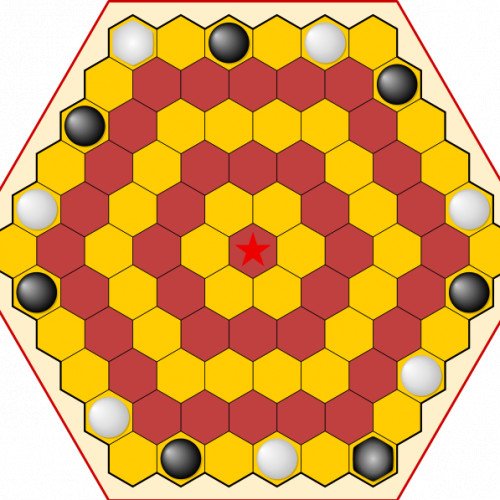AGON VS TANTRIX

AGON
Agon (or Queen's Guards or Royal Guards) is an strategy game invented by Anthony Peacock of London, and first published in 1842. It is a two player game played on a 6×6×6 hexagonal gameboard, and is notable for being the oldest known board game played on a board of hexagonal cells. Each player has one queen and six guards. Players determine who moves first, then turns alternate. On each turn, a player moves one of his pieces. The object of the game is to be first to maneuver one's queen to the central hex (the throne) at the center of the board, and surround her with all six of her guards. The gameboard may be thought of as a series of concentric rings of hex cells (highlighted by rings of alternating colors). Pieces move one step at a time to an adjacent cell, either sideways in the same ring, or towards the throne to the next ring. The cell moved to must be vacant. Only the queen may move to the throne.
Statistics for this Xoptio

TANTRIX
Tantrix is a hexagonal tile-based abstract game invented by Mike McManaway from New Zealand. Each of the 56 different tiles in the set contains three lines, going from one edge of the tile to another. No two lines on a tile have the same colour. There are four colours in the set: red, yellow, blue, and green. No two tiles are identical, and each is individually numbered from 1 through 56. In the multiplayer version of the game, each player chooses a colour, so there are between two and four players. Each draws one tile from the bag, and the person who draws the highest number goes first. Each player then takes five more tiles from the bag, and places all six tiles face up in front of them. The first person plays one tile, usually with their colour on it. Play then rotates clockwise. After playing a tile, each player takes a replacement tile from the bag, so that they always have six in front of them. Tiles played must match the colour of the edges adjoining it. When three tiles surround an empty space so that it is effectively half covered this is called a forced space. If the person whose turn it is has a tile that fills that space they must play it. The player repeats this process until there are no more forced spaces that they can fill, at which stage they make a free move, where they can play any tile as long as they don't breach the three restriction rules given below. Once they have had a free move, they must then fill any more forced spaces that they can. Thus one player's turn can consist of several moves.